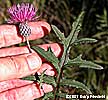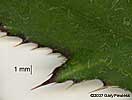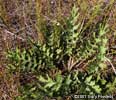
Wetland Plants of Wisconsin
| Cirsium muticum Michx. swamp thistle Family: Asteraceae |
||||||||||||||||||
|
||||||||||||||||||
|
Ten species of thistles (genus Cirsium) have been documented in Wisconsin. Many people are familiar with two weedy alien species and may not look closer to see that there are some native species as well. Cirsium muticum is one of the native species and, as the title suggests, is associated with wet habitats. Thistles are probably best known for their spines, specifically for sharp, stiff, conical spines at the tips of leaf lobes and often at the tips of the phyllaries (bracts surrounding the base of each flower head; all phyllaries collectively are referred to as the involucre). All of our thistles have such spines at the tips of phyllaries, except for three and C. muticum is one of those. One of the three, Cirsium palustre, is easily distinguished from the group by the presence of spine-tipped leaf bases decurrent along the stem below the middle stem leaves (see photo for C. palustre). The other species is the common terrestrial weed C. arvense, a perennial with rhizomes, compared to the biennial habit of C. muticum. The involucres of C. muticum are generally taller ( > 22 mm) than those of C. arvense (<20 mm) and the phyllaries of C. muticum are usually wooly pubescent whereas those of C. arvense are glabrous or nearly so. In northern Wisconsin Cirsium muticum is often associated with wet forests, especially on organic soils at springs and it appears to be most common on basic soils. C. arvense is an abundant terestrial weed, often forming large clones there, but it is sometimes present on exposed wet soils, wet sand bars, etc.
|
|







